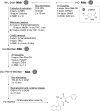Cyclic Dipeptide Shuttles as a Novel Skin Penetration Enhancement Approach: Preliminary Evaluation with Diclofenac
- PMID: 27548780
- PMCID: PMC4993479
- DOI: 10.1371/journal.pone.0160973
Cyclic Dipeptide Shuttles as a Novel Skin Penetration Enhancement Approach: Preliminary Evaluation with Diclofenac
Abstract
This study demonstrates the effectiveness of a peptide shuttle in delivering diclofenac into and through human epidermis. Diclofenac was conjugated to a novel phenylalanyl-N-methyl-naphthalenylalanine-derived diketopiperazine (DKP) shuttle and to TAT (a classical cell penetrating peptide), and topically applied to human epidermis in vitro. DKP and TAT effectively permeated into and through human epidermis. When conjugated to diclofenac, both DKP and TAT enhanced delivery into and through human epidermis, though DKP was significantly more effective. Penetration of diclofenac through human epidermis (to receptor) was increased by conjugation to the peptide shuttle and cell penetrating peptide with enhancement of 6x by DKP-diclofenac and 3x by TAT-diclofenac. In addition, the amount of diclofenac retained within the epidermis was significantly increased by peptide conjugation. COX-2 inhibition activity of diclofenac was retained when conjugated to DKP. Our study suggests that the peptide shuttle approach may offer a new strategy for targeted delivery of small therapeutic and diagnostic molecules to the skin.
Conflict of interest statement
The authors have declared that no competing interests exist.
Figures






Similar articles
-
Enhanced transdermal delivery of a dipeptide by dermaportation.Biopolymers. 2008;90(5):655-62. doi: 10.1002/bip.21033. Biopolymers. 2008. PMID: 18536044
-
Lecithin vesicles for topical delivery of diclofenac.Eur J Pharm Biopharm. 2003 Nov;56(3):389-92. doi: 10.1016/s0939-6411(03)00143-7. Eur J Pharm Biopharm. 2003. PMID: 14602181
-
Potent enhancement of GFP uptake into HT-29 cells and rat skin permeation by coincubation with tat peptide.J Pharm Sci. 2011 Nov;100(11):4766-73. doi: 10.1002/jps.22671. Epub 2011 Jun 16. J Pharm Sci. 2011. PMID: 21681754
-
The taming of the cell penetrating domain of the HIV Tat: myths and realities.J Control Release. 2007 Feb 12;117(2):148-62. doi: 10.1016/j.jconrel.2006.10.031. Epub 2006 Nov 17. J Control Release. 2007. PMID: 17196289 Free PMC article. Review.
-
Intracellular cargo delivery using tat peptide and derivatives.Med Res Rev. 2004 Jan;24(1):1-12. doi: 10.1002/med.10056. Med Res Rev. 2004. PMID: 14595670 Review.
Cited by
-
Impact of Different Packaging Configurations on A Topical Cream Product.Pharm Res. 2024 Oct;41(10):2043-2056. doi: 10.1007/s11095-024-03772-5. Epub 2024 Sep 30. Pharm Res. 2024. PMID: 39349693 Free PMC article.
-
Cell-Penetrating Peptides as Passive Permeation Enhancers for Transdermal Drug Delivery.AAPS PharmSciTech. 2022 Sep 26;23(7):266. doi: 10.1208/s12249-022-02424-4. AAPS PharmSciTech. 2022. PMID: 36163537 Review.
-
Topical Semisolid Drug Product Critical Quality Attributes with Relevance to Cutaneous Bioavailability and Pharmacokinetics: Part I-Bioequivalence of Acyclovir Topical Creams.Pharm Res. 2024 Jul;41(7):1507-1520. doi: 10.1007/s11095-024-03736-9. Epub 2024 Jul 2. Pharm Res. 2024. PMID: 38955999 Free PMC article.
-
Efficient transdermal delivery of functional protein cargoes by a hydrophobic peptide MTD 1067.Sci Rep. 2022 Jun 27;12(1):10853. doi: 10.1038/s41598-022-14463-9. Sci Rep. 2022. PMID: 35760980 Free PMC article.
References
-
- Benson HA. Transdermal drug delivery: penetration enhancement techniques. Current drug delivery. 2005;2(1):23–33. Epub 2005/11/25. . - PubMed
-
- Wang F, Wang Y, Zhang X, Zhang W, Guo S, Jin F. Recent progress of cell-penetrating peptides as new carriers for intracellular cargo delivery. Journal of controlled release: official journal of the Controlled Release Society. 2014;174:126–36. Epub 2013/12/03. 10.1016/j.jconrel.2013.11.020 . - DOI - PubMed
MeSH terms
Substances
LinkOut - more resources
Full Text Sources
Other Literature Sources
Research Materials

